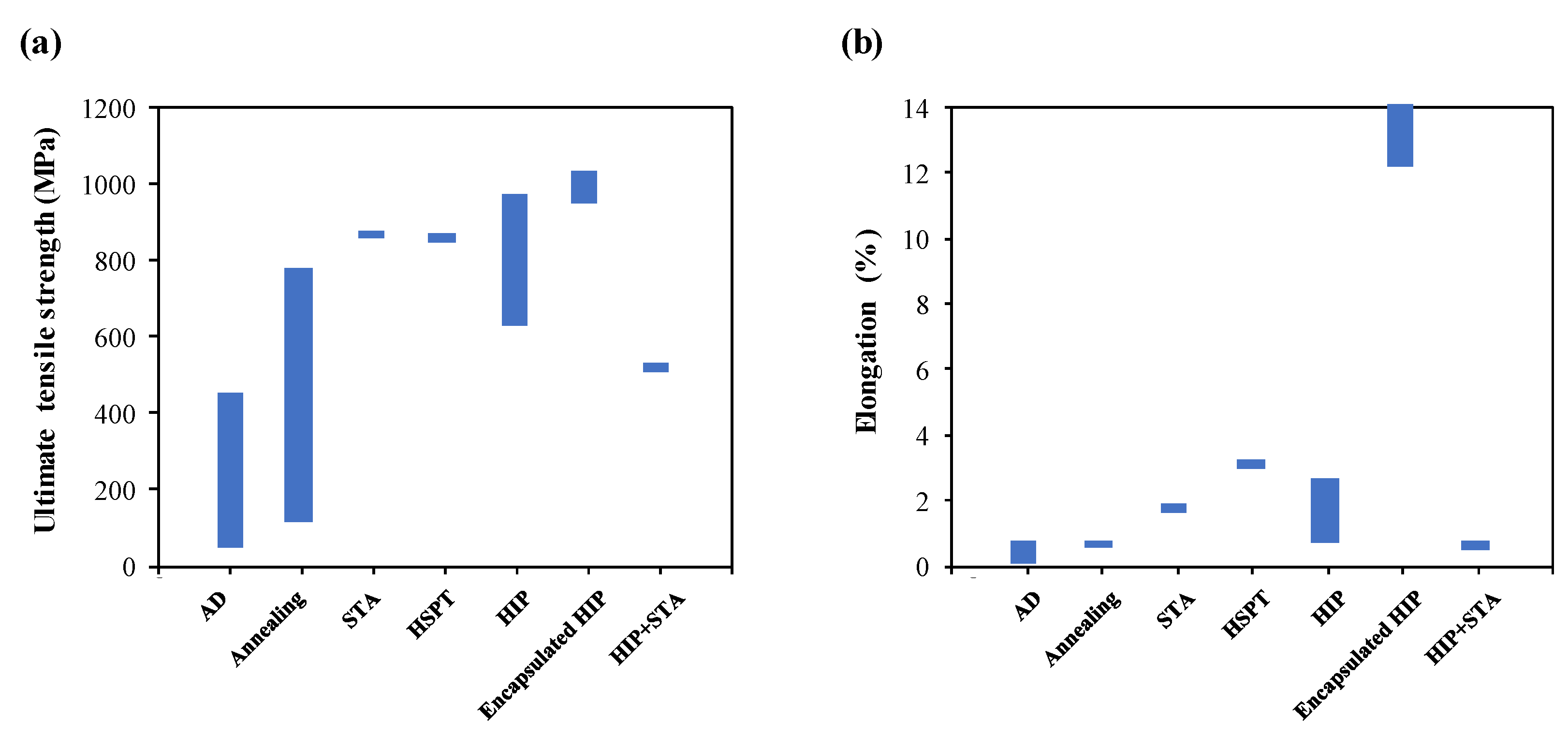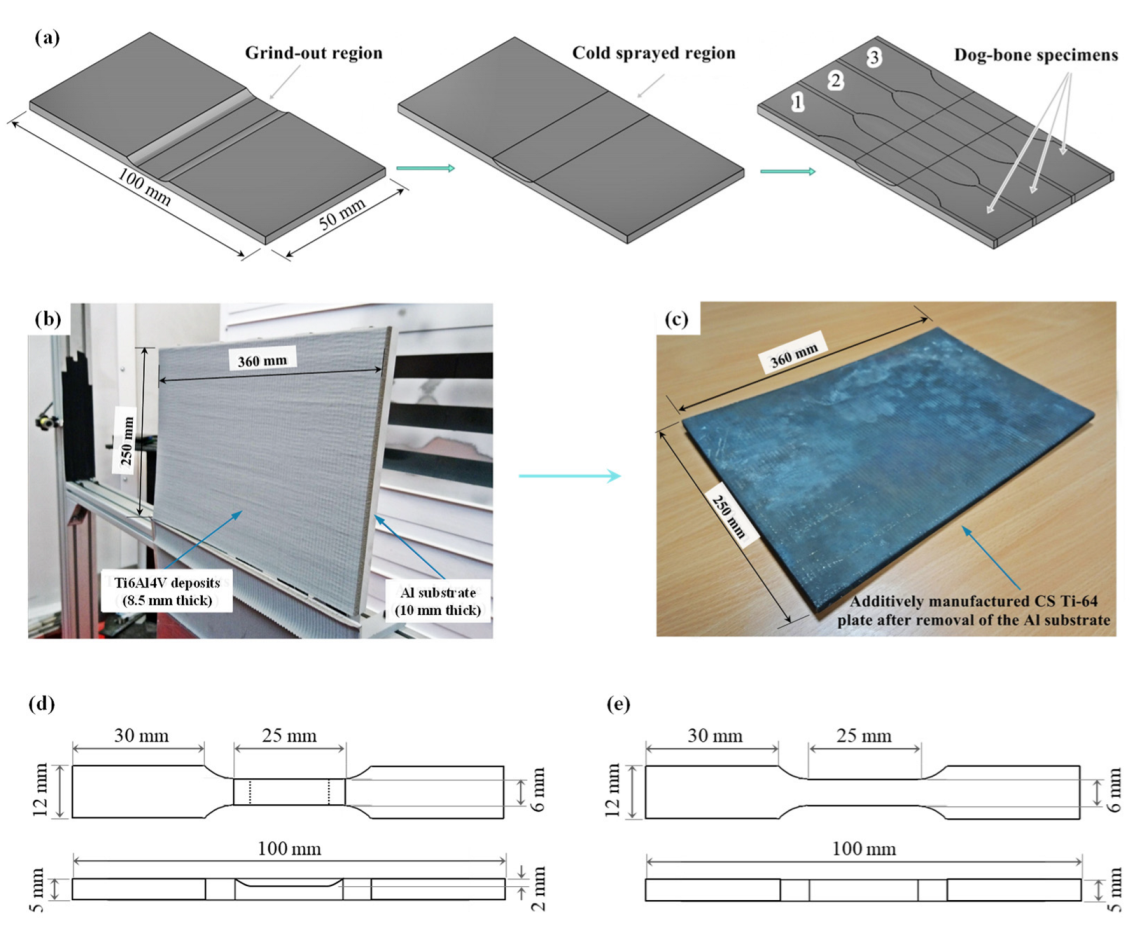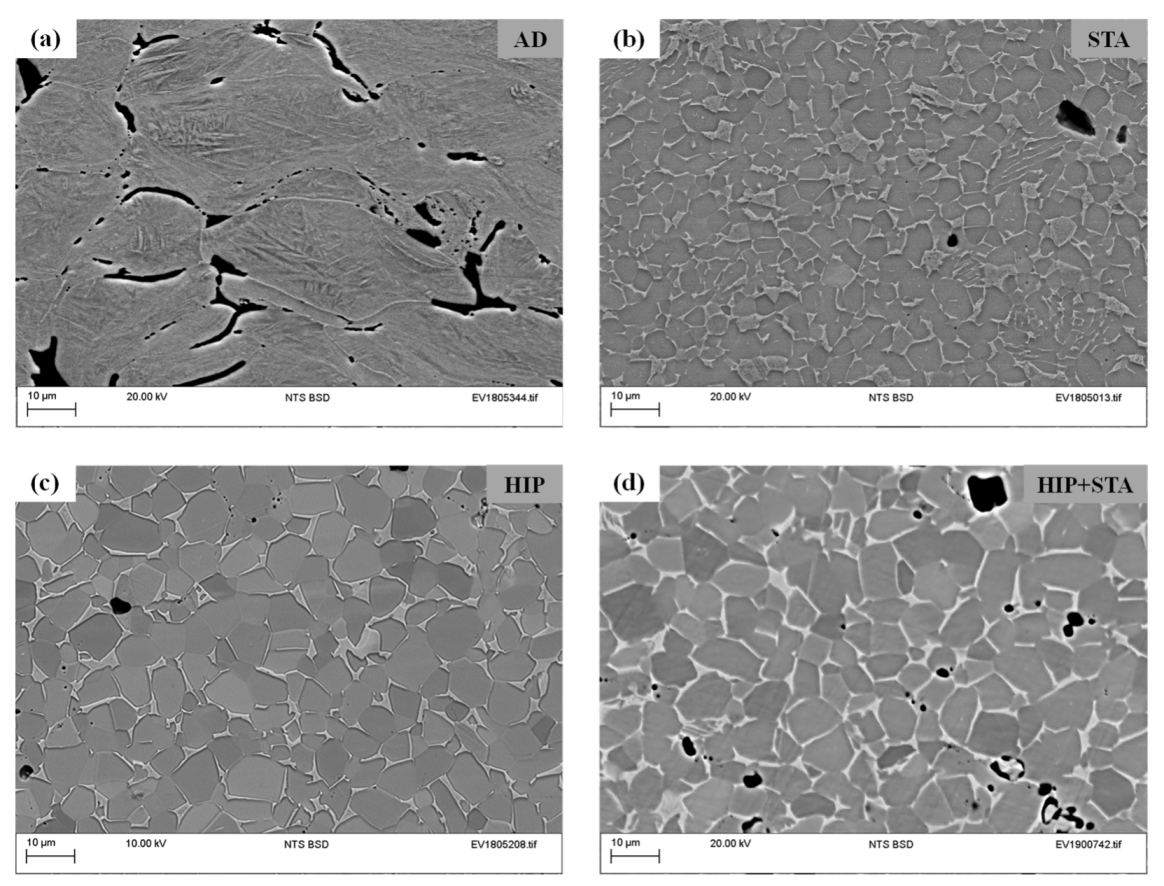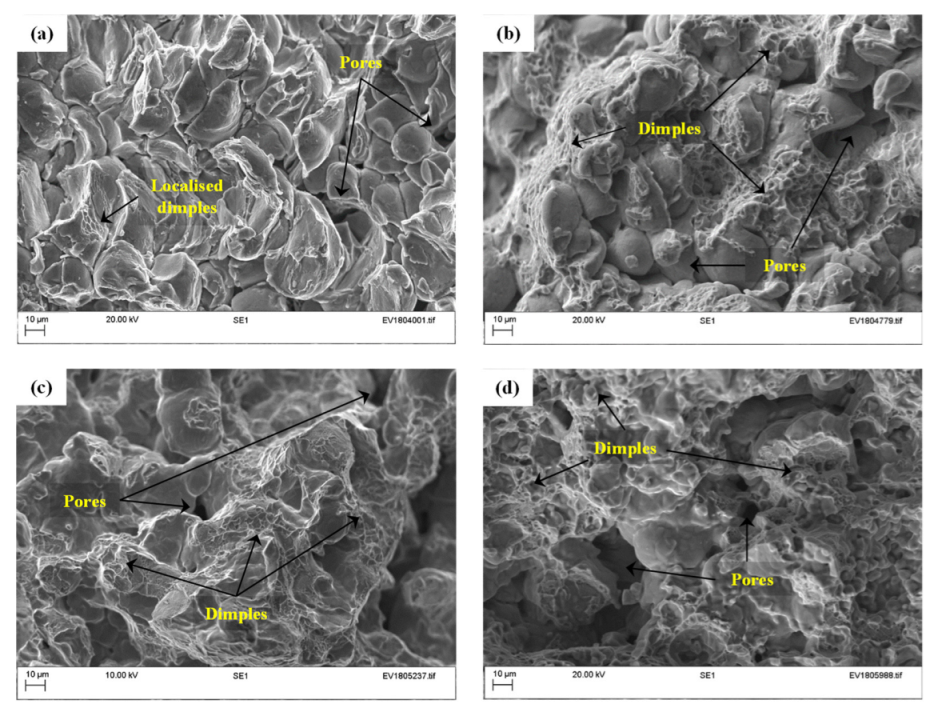Effect of Post-Deposition Thermal Treatments on Tensile Properties of Cold Sprayed Ti6Al4V
Abstract
1. Introduction
2. Materials and Methods
2.1. Substrate Material and Feedstock Powder
2.2. Cold Spray System and Process Conditions
2.3. Post-Deposition Thermal Treatments
- (i)
- Solution treatment and ageing (STA): STA is an established technique that can improve the strength of Ti6Al4V alloy while maintaining its ductility. A wide range of microstructure and mechanical properties can be achieved in α-β alloys after STA treatment, which originates in the instability of high-temperature β phase at lower temperatures. Heating α-β alloy to the solution-treating temperature (generally 25–85 °C below β-transus) increases the ratio of β to α phase. This partitioning of phases is maintained following quenching. Subsequent ageing treatment (425–650 °C) promotes the decomposition of unstable β phase and any martensite, producing a finely divided mixture of α and β phase, resulting in increased strength [26,27]. In this study, solution treatment was performed under vacuum at 940 °C for 1 h followed by argon fast cooling and aged at 480 °C for 8 h followed by furnace cooling to room temperature.
- (ii)
- Hot isostatic pressing (HIP): HIP is a widely accepted thermo-mechanical method for closing internal defects (except surface connected pores) in titanium castings or additively manufactured parts. In the HIP process, chemically cleaned parts were loaded inside a HIP chamber which later on was filled with high-purity argon gas to create high pressure (usually in the range of 70–205 MPa) and temperature (900–955 °C for titanium) for some fixed dwell time, e.g., 2–4 h. As the yield strength of the material drops at high temperatures, the application of pressure results in high diffusion rates and the plastic flow of the material, which helps to close any voids or microcracks [27,28]. In this study, HIP treatment was performed at 140 MPa and 930 °C for a duration of 4 h.
- (iii)
- HIP followed by STA (HIP + STA): Several studies reported that HIP temperatures can coarsen α platelets, causing a reduction in tensile strength of the material. Therefore, to recover the strength of the material, STA treatment is generally performed after HIP [27,28]. Parameters used for HIP + STA treatment was the same as mentioned earlier for STA and HIP.
2.4. Microstructural Characterisation
2.5. Evaluation of Mechanical Properties
3. Results
3.1. Microstructure and Porosity
3.2. Mechanical Properties
3.2.1. Hardness
3.2.2. Tensile Properties
4. Discussion
4.1. Overview
| Process Gas | Temperature (°C)/Pressure (MPa) | Testing Condition | Porosity (%) | UTS (MPa) | Elongation (%) | E (GPa) | Measurement Method | References (et al.) |
|---|---|---|---|---|---|---|---|---|
| He | 450–530/2.4 | As-deposited | 18–26 | 52–109 | 0.16–0.48 | 28 | ASTM E8 (sub-size round) | Blose [13] |
| Annealing a1 | 18–26 | 236–244 | 0.64–0.68 | 61 | ||||
| Encapsulated HIP b1 | ~0 | 890–1024 | 12.3–14.0 | 115 | ||||
| 350/4 | As-deposited | ~0.3 | 445 ± 145 | 3.8 ± 0.8 * | - | MFT e1 | Vo [3] | |
| Annealing a2 | ~0.3 | 764 ± 189 | 6.3 ± 0.5 * | - | ||||
| 950/2 | As-deposited | ~1.2 | 373 ± 10 | ~0.46 | 75 | ASTM E8 (sub-size flat) | Chen [14] | |
| HIP b2 | ~0.04 | 962 ± 31 | ~1.76 | 80 | ||||
| N2 | 800/4 | As-deposited | ~6.7 ~6.7 | ~160 | - | - | MFT e1 | Wong [8] |
| Annealing a3 | ~160 | - | - | |||||
| 800/4 | As-deposited | 5–12 | 154 ± 81 | 2.3 ± 0.9 * | - | MFT e1 | Vo [3] | |
| Annealing a4 | 5–12 | 251–273 | 3.2–4.7 * | - | ||||
| Annealing a5 | 5–12 | 144–219 | 2.2–3.5 * | - | ||||
| Annealing a6 | 5–12 | 180–462 | 3.0–5.8 * | - | ||||
| 800–1000/4–5 | As-deposited | 4.6–10.4 | 182–263 | - | - | TCT e2 | List [9] | |
| 157–295 | - | - | MFT e1 | |||||
| 950/5 | As-deposited | ~2.4 | 85 ± 3 | ~0.27 | 31 | ASTM E8 (sub-size flat) | Chen [14] | |
| HIP b2 | ~1.5 | 664 ± 21 | ~1.40 | 55 | ||||
| 950/4.5 | As-deposited | 4–5 | 337 ± 17 | 4.4–5.3 * | - | MFT e1 | Tan [10] | |
| 600/5 | As-deposited | 7.5 | 68 ± 5 | 0.54 | 99 | ASTM E8 (sub-size flat) | Petrovskiy [15] | |
| Encapsulated HIP b3 | 0.2 | 956 ± 5 | 13.5 ± 0.5 | 99 | ||||
| 800/4 | As-deposited | ~6.5 | 105 | 0.65 | - | ASTM E8 (sub-size flat) | Petrovskiy [16] | |
| HIP b4 | 4.9–5.2 | 635 | 0.97 | - | ||||
| - | - | As-deposited | - | 147 | 0.24 | 61 | MFT specimen with DIC e3 | Ligda [11] |
| HIP b5 | - | 798 | 2.5 | 86 | ||||
| HSPT c1 | - | 859 | 3.1 | 91 | ||||
| N2 | 1100/5 | As-deposited | 2.25 | 287 ± 7 | 0.44 ± 0.03 | 77 ± 2 | ASTM E8 (sub-size flat) | This study |
| STA d1 | 1.74 | 868 ± 44 | 1.23 ± 0.27 | 109 ± 1 | ||||
| HIP b6 | 1.78 | 747 ± 42 | 0.76 ± 0.08 | 110 ± 3 | ||||
| HIP b6 + STA d1 | 4.40 | 521 ± 14 | 0.61 ± 0.08 | 95 ± 10 |

4.2. Effect of Thermal Treatments on Ultimate Tensile Strength
4.3. Effect of Thermal Treatments on Elongation
4.4. Effect of Thermal Treatments on Elastic Modulus
4.5. Key Takeaways
5. Conclusions
- Post-deposition thermal treatments led to complete disappearance of the microstructural features found in the as-deposited condition, resulting in coarsened microstructure having equiaxed α grains with intergranular β precipitates. Porosity (in terms of area fraction) was reduced from 2.3% in the as-deposited condition to 1.7% after STA, and/or HIP treatment.
- STA and HIP treatments lowered hardness by 15–17% due to microstructural softening in the CS deposits caused by static recovery mechanisms during high-temperature thermal treatments.
- Post-deposition thermal treatments resulted in significant improvement in the tensile strength, which is mainly attributed to increase in cohesion strength between deposited particles due to improved metallurgical inter-particle diffusion bonding, homogenisation of microstructure, and in some cases reduction in porosity. For the fully CS material, the ultimate tensile strength (UTS) was improved the most by around 200%, from 287 MPa in AD to 868 MPa after STA.
- Elongation was much lower for all investigated cases with the highest measured value (averaged) of 1.23% after STA.
- For CS repair specimens (repair ratio 2:5), both STA and HIP treatments improved the UTS by 209%, from 308 to 951 MPa, elongation from 0.35% to 3.01% after STA, and to 4.32% after HIP. Better performance in repair specimens (compared to fully CS specimens) could be due to the contribution of the substrate material (mil annealed Ti6Al4V) towards the overall performance.
Author Contributions
Funding
Institutional Review Board Statement
Informed Consent Statement
Data Availability Statement
Acknowledgments
Conflicts of Interest
Appendix A. Tensile Strength for Specimens with Different Repair Ratios

References
- Boyer, R.R. An overview on the use of titanium in the aerospace industry. Mater. Sci. Eng. A 1996, 213, 103–114. [Google Scholar] [CrossRef]
- Inagaki, I.; Takechi, T.; Shirai, Y.; Ariyasu, N. Application and Features of Titanium for the Aerospace Industry; Nippon Steel: Shimaya, Japan, 2014. [Google Scholar]
- Vo, P.; Irissou, E.; Legoux, J.-G.; Yue, S. Mechanical and Microstructural Characterization of Cold-Sprayed Ti-6Al-4V After Heat Treatment. J. Therm. Spray Technol. 2013, 22, 954–964. [Google Scholar] [CrossRef]
- Li, W.; Cao, C.; Yin, S. Solid-state cold spraying of Ti and its alloys: A literature review. Prog. Mater. Sci. 2019, 110, 100633. [Google Scholar] [CrossRef]
- Sova, A.; Grigoriev, S.; Okunkova, A.; Smurov, I. Potential of cold gas dynamic spray as additive manufacturing technology. Int. J. Adv. Manuf. Technol. 2013, 69, 2269–2278. [Google Scholar] [CrossRef]
- Blose, R.; Walker, B.; Walker, R.; Froes, S. New opportunities to use cold spray process for applying additive features to titanium alloys. Met. Powder Rep. 2006, 61, 30–37. [Google Scholar] [CrossRef]
- Boruah, D. Structural Integrity Assessment of Cold Spray Additive Manufactured Titanium Alloy Ti-6Al-4V. Ph.D. Thesis, Coventry University, Coventry, UK, 2020. [Google Scholar]
- Wong, W.; Irissou, E.; Legoux, J.G.; Vo, P.; Yue, S. Powder Processing and Coating Heat Treatment on Cold Sprayed Ti-6Al-4V Alloy. Mater. Sci. Forum 2012, 706–709, 258–263. [Google Scholar] [CrossRef]
- List, A.; Lyphout, C.; Villa, M.; Gärtner, F.; Klassen, T. Mechanical Properties of Cold-Sprayed Ti-6Al-4V Coatings. In Proceedings of the International Thermal Spray Conference and Exposition: Innovative Coating Solutions for the Global Economy, ITSC 2013, Busan, Korea, 13–15 May 2013. [Google Scholar]
- Tan, A.W.-Y.; Sun, W.; Bhowmik, A.; Lek, J.Y.; Song, X.; Zhai, W.; Zheng, H.; Li, F.; Marinescu, I.; Dong, Z.; et al. Effect of Substrate Surface Roughness on Microstructure and Mechanical Properties of Cold-Sprayed Ti6Al4V Coatings on Ti6Al4V Substrates. J. Therm. Spray Technol. 2019, 28, 1959–1973. [Google Scholar] [CrossRef]
- Ligda, J.P.; Butler, B.G.; Saenz, N.; Paramore, J. Mechanical Behavior of Additively Manufactured Ti-6Al-4V Following a New Heat Treatment. In Mechanics of Additive and Advanced Manufacturing; Kramer, S., Jordan, J.L., Jin, H., Carroll, J., Eds.; Springer International Publishing: Cham, Switzerland, 2019; pp. 29–30. [Google Scholar]
- Schmidt, T.; Gärtner, F.; Kreye, H. Tubular-Coating-Tensile-Test; Helmut Schmidt University: Hamburg, Germany, 2006. [Google Scholar]
- Blose, R.E. Spray Forming Titanium Alloys Using the Cold Spray Process. In Proceedings of the International Thermal Spray Conference, ASM International, Basel, Switzerland, 2–4 May 2005. [Google Scholar]
- Chen, C.; Xie, Y.; Yan, X.; Yin, S.; Fukanuma, H.; Huang, R.; Zhao, R.; Wang, J.; Ren, Z.; Liu, M.; et al. Effect of hot isostatic pressing (HIP) on microstructure and mechanical properties of Ti6Al4V alloy fabricated by cold spray additive manufacturing. Addit. Manuf. 2019, 27, 595–605. [Google Scholar] [CrossRef]
- Petrovskiy, P.; Travyanov, A.; Cheverikin, V.V.; Chereshneva, A.A.; Sova, A.; Smurov, I. Effect of encapsulated hot isostatic pressing on properties of Ti6Al4V deposits produced by cold spray. Int. J. Adv. Manuf. Technol. 2020, 107, 437–449. [Google Scholar] [CrossRef]
- Petrovskiy, P.; Khomutov, M.; Cheverikin, V.; Travyanov, A.; Sova, A.; Smurov, I. Influence of hot isostatic pressing on the properties of 316L stainless steel, Al-Mg-Sc-Zr alloy, titanium and Ti6Al4V cold spray deposits. Surf. Coat. Technol. 2021, 405, 126736. [Google Scholar] [CrossRef]
- Zhou, H.; Li, C.; Yang, H.; Luo, X.; Yang, G.; Li, W.; Hussain, T.; Li, C. Pores Structure Change Induced by Heat Treatment in Cold-Sprayed Ti6Al4V Coating. J. Therm. Spray Technol. 2019, 28, 1199–1211. [Google Scholar] [CrossRef]
- Khun, N.W.; Tan, A.W.Y.; Sun, W.; Liu, E. Effect of Heat Treatment Temperature on Microstructure and Mechanical and Tribological Properties of Cold Sprayed Ti-6Al-4V Coatings. Tribol. Trans. 2016, 60, 1033–1042. [Google Scholar] [CrossRef]
- Bhowmik, A.; Tan, A.W.; Sun, W.; Wei, Z.; Marinescu, I. On the heat-treatment induced evolution of residual stress and remarkable enhancement of adhesion strength of cold sprayed Ti-6Al-4V coatings. Results Mater. 2020, 7, 100119. [Google Scholar] [CrossRef]
- Li, W.Y.; Zhang, C.; Guo, X.; Xu, J.; Li, C.J.; Liao, H.; Coddet, C.; Khor, K.A. Ti and Ti-6Al-4V coatings by cold spraying and microstructure modification by heat treatment. Adv. Eng. Mater. 2007, 9, 418–423. [Google Scholar]
- Bhattiprolu, V.S.; Johnson, K.W.; Crawford, G.A. Influence of Powder Microstructure on the Microstructural Evolution of As-Sprayed and Heat Treated Cold-Sprayed Ti-6Al- 4V Coatings. J. Therm. Spray Technol. 2019, 28, 174–188. [Google Scholar] [CrossRef]
- Garrido, M.; Sirvent, P.; Poza, P. Evaluation of mechanical properties of Ti6Al4V cold sprayed coatings. Surf. Eng. 2017, 34, 399–406. [Google Scholar] [CrossRef]
- Boruah, D.; Zhang, X. Effect of Post-Deposition Solution Treatment and Ageing on Improving Interfacial Adhesion Strength of Cold Sprayed Ti6Al4V Coatings. Metals 2021, 11, 2038. [Google Scholar] [CrossRef]
- Boruah, D.; Robinson, B.; London, T.; Wu, H.; de Villiers-Lovelock, H.; McNutt, P.; Doré, M.; Zhang, X. Experimental evaluation of interfacial adhesion strength of cold sprayed Ti-6Al-4V thick coatings using an adhesive-free test method. Surf. Coat. Technol. 2019, 381, 125130. [Google Scholar] [CrossRef]
- Boruah, D.; Ahmad, B.; Lee, T.L.; Kabra, S.; Syed, A.K.; McNutt, P.; Doré, M.; Zhang, X. Evaluation of residual stresses induced by cold spraying of Ti-6Al-4V on Ti-6Al-4V substrates. Surf. Coat. Technol. 2019, 374, 591–602. [Google Scholar] [CrossRef]
- Gupta, R.K.; Kumar, V.A.; Chhangani, S. Study on Variants of Solution Treatment and Aging Cycle of Titanium Alloy Ti6Al4V. J. Mater. Eng. Perform. 2016, 25, 1492–1501. [Google Scholar] [CrossRef]
- Matthew, J.; Donachie, J. Heat treating titanium and its alloys. Heat Treat. Prog. 2001, 1, 47–57. [Google Scholar]
- Soundarapandiyan, G.; Chen, B.; Fitzpatrick, M. Effect of postprocessing thermal treatments on electron-beam powder bed–fused Ti6Al4V. Mater. Des. Process. Commun. 2020, 3, 1–8. [Google Scholar] [CrossRef]
- ASTM E2109-01; Standard Test Methods for Determining Area Percentage Porosity in Thermal Sprayed Coatings. ASTM Int.: West Conshohocken, PA, USA, 2014.
- ASTM E384-17; Standard Test Method for Microindentation Hardness of Materials. ASTM Int.: West Conshohocken, PA, USA, 2017.
- ISO 14577-1; Metallic Materials—Instrumented Indentation Test for Hardness and Materials Parameters—Part 1: Test Method. ISO: Geneva, Switzerland, 2015.
- ASTM E8/E8M-16a; Standard Test Methods for Tension Testing of Metallic Materials. ASTM Int.: West Conshohocken, PA, USA, 2016.
- ASTM E111-17; Standard Test Method for Young’s Modulus, Tangent Modulus, and Chord Modulus. ASTM Int.: West Conshohocken, PA, USA, 2017.
- ASTM E1876-15; Standard Test Method for Dynamic Young’s Modulus, Shear Modulus, and Poisson’s Ratio by Impulse Excitation of Vibration. ASTM Int.: West Conshohocken, PA, USA,, 2015.
- Lek, J.Y.; Bhowmik, A.; Tan, A.W.Y.; Sun, W.; Song, X.; Zhai, W.; Buenconsejo, P.J.; Li, F.; Liu, E.; Lam, Y.M.; et al. Understanding the microstructural evolution of cold sprayed Ti-6Al-4V coatings on Ti-6Al-4V substrates. Appl. Surf. Sci. 2018, 459, 492–504. [Google Scholar] [CrossRef]
- Birt, A.M.; Champagne, V.K.; Sisson, R.D.; Apelian, D. Microstructural Analysis of Cold-Sprayed Ti-6Al-4V at the Micro- and Nano-Scale. J. Therm. Spray Technol. 2015, 24, 1277–1288. [Google Scholar] [CrossRef]
- Tan, A.W.-Y.; Sun, W.; Bhowmik, A.; Lek, J.Y.; Marinescu, I.; Li, F.; Khun, N.W.; Dong, Z.; Liu, E. Effect of coating thickness on microstructure, mechanical properties and fracture behaviour of cold sprayed Ti6Al4V coatings on Ti6Al4V substrates. Surf. Coat. Technol. 2018, 349, 303–317. [Google Scholar] [CrossRef]
- Tammas-Williams, S.; Withers, P.; Todd, I.; Prangnell, P. Porosity regrowth during heat treatment of hot isostatically pressed additively manufactured titanium components. Scr. Mater. 2016, 122, 72–76. [Google Scholar] [CrossRef]
- Gärtner, F.; Stoltenhoff, T.; Voyer, J.; Kreye, H.; Riekehr, S.; Koçak, M. Mechanical properties of cold-sprayed and thermally sprayed copper coatings. Surf. Coat. Technol. 2006, 200, 6770–6782. [Google Scholar] [CrossRef]
- WebPlotDigitizer v4.5. Extract Data from Plots, Images, and Maps, (n.d.). Oakland, CA, USA, 2022. Available online: https://automeris.io/WebPlotDigitizer/ (accessed on 2 January 2020).
- Rice, R.C.; Jackson, J.L.; Bakuckas, J.; Thompson, S. Metallic Materials Properties Development and Standardization (MMPDS); SAE: Springfield, VA, USA, 2003. [Google Scholar]





| CS system setup | Gun | CS system | Impact 5/11 |
| Nozzle | T24-SiC | ||
| Pre-chamber | Long (128.6 mm) | ||
| Process gas | Nitrogen (N2) | ||
| Gas pressure (MPa) | 5 | ||
| Gas temperature (°C) | 1100 | ||
| Powder feeder | Dosing disk rotation speed (rpm) | 3 | |
| Powder feed rate (g/min) | 24.67 | ||
| Carrier gas flow rate (m3/h) | 3 | ||
| Nozzle cooling medium | Water | ||
| Robot and toolpath setup | Gun traverse or scanning speed (mm/s) | 500 | |
| Track spacing (mm) | 2 | ||
| Spray angle (°) | 90 | ||
| Standoff distance (mm) | 30 | ||
| Toolpath pattern | Cross-hatch | ||
Publisher’s Note: MDPI stays neutral with regard to jurisdictional claims in published maps and institutional affiliations. |
© 2022 by the authors. Licensee MDPI, Basel, Switzerland. This article is an open access article distributed under the terms and conditions of the Creative Commons Attribution (CC BY) license (https://creativecommons.org/licenses/by/4.0/).
Share and Cite
Boruah, D.; Zhang, X.; McNutt, P.; Khan, R.; Begg, H. Effect of Post-Deposition Thermal Treatments on Tensile Properties of Cold Sprayed Ti6Al4V. Metals 2022, 12, 1908. https://doi.org/10.3390/met12111908
Boruah D, Zhang X, McNutt P, Khan R, Begg H. Effect of Post-Deposition Thermal Treatments on Tensile Properties of Cold Sprayed Ti6Al4V. Metals. 2022; 12(11):1908. https://doi.org/10.3390/met12111908
Chicago/Turabian StyleBoruah, Dibakor, Xiang Zhang, Philip McNutt, Raja Khan, and Henry Begg. 2022. "Effect of Post-Deposition Thermal Treatments on Tensile Properties of Cold Sprayed Ti6Al4V" Metals 12, no. 11: 1908. https://doi.org/10.3390/met12111908
APA StyleBoruah, D., Zhang, X., McNutt, P., Khan, R., & Begg, H. (2022). Effect of Post-Deposition Thermal Treatments on Tensile Properties of Cold Sprayed Ti6Al4V. Metals, 12(11), 1908. https://doi.org/10.3390/met12111908








